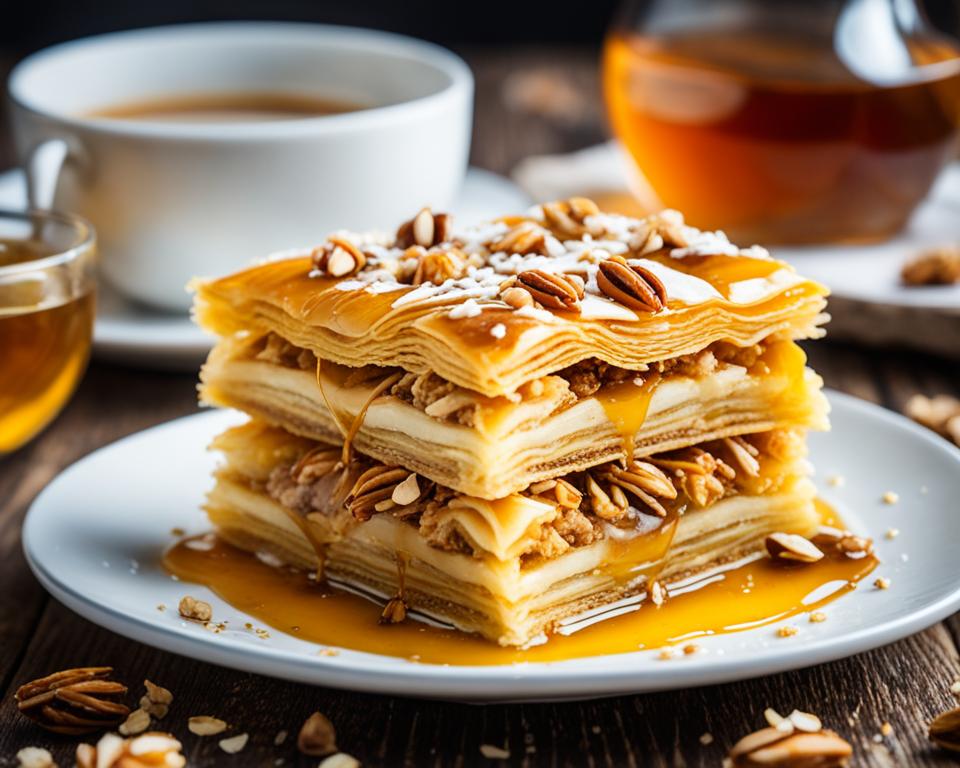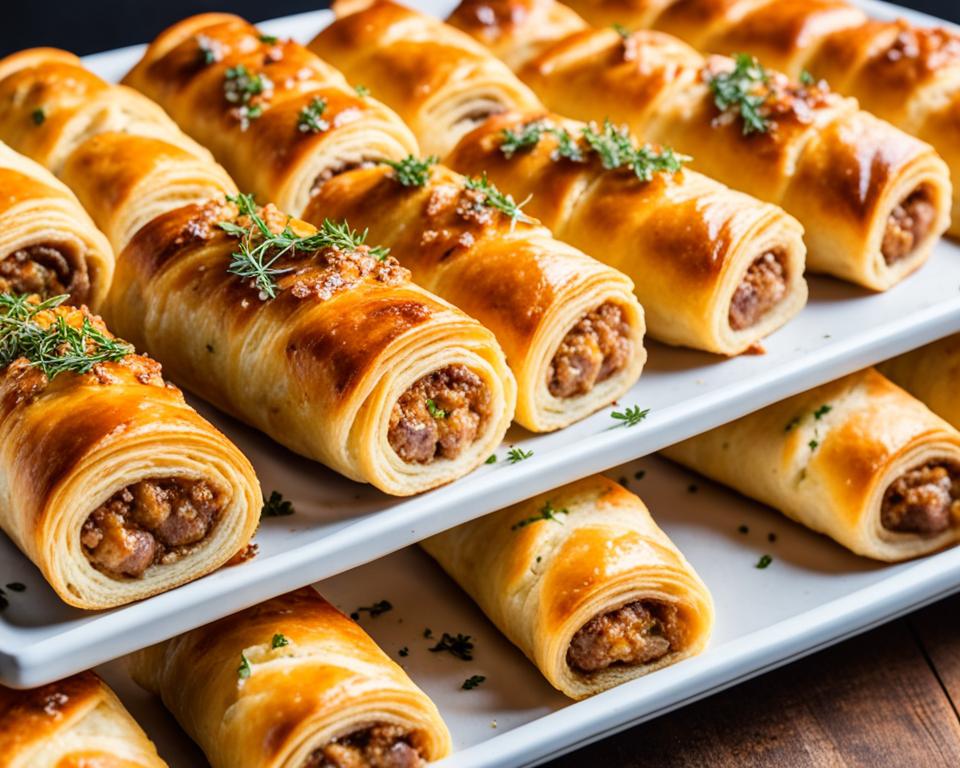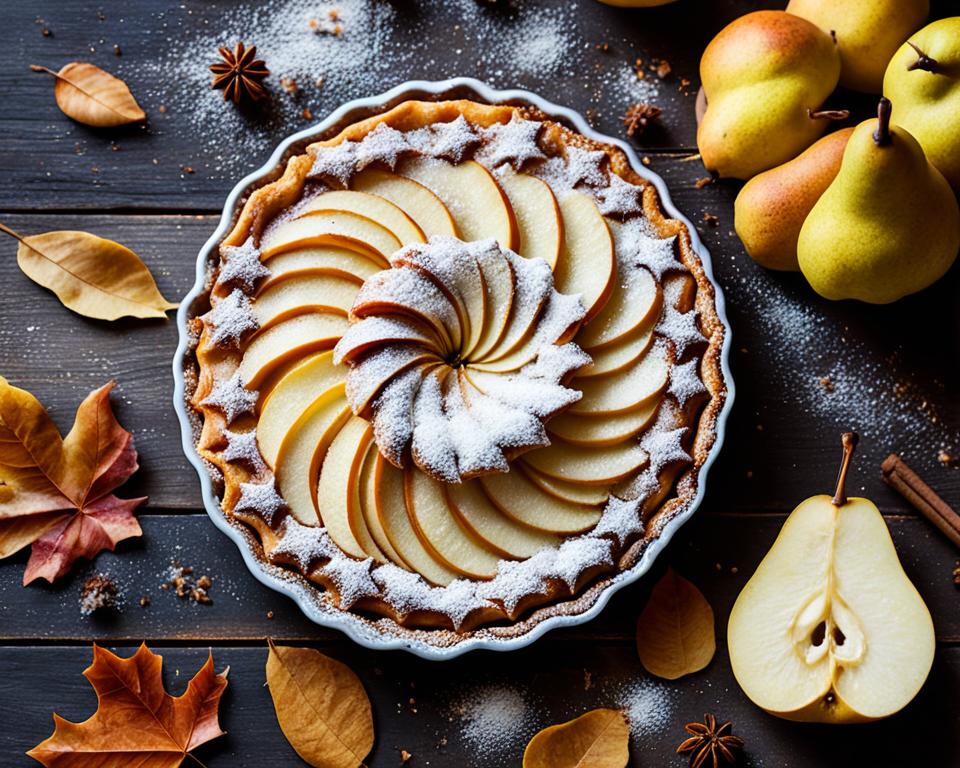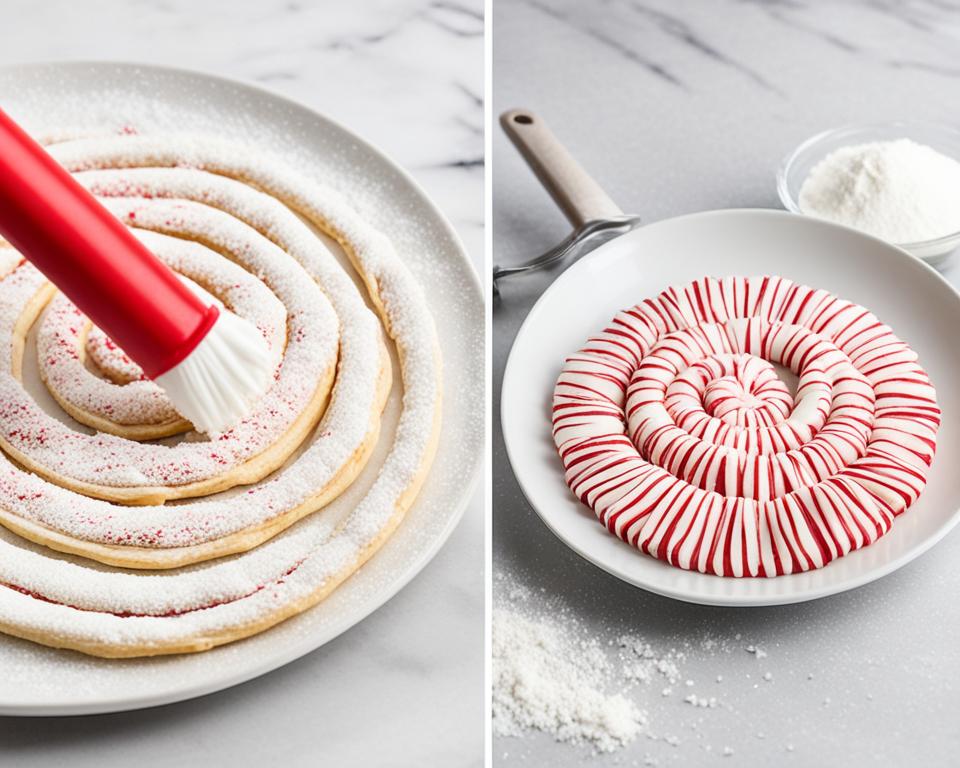When the quest for the ultimate homemade delight leads one to explore Greek desserts, there is no overlooking the classical favorite – baklava. This Best Baklava Recipe has been fine-tuned to evoke the serenity of Greek waves and the warm embrace of Mediterranean sunsets with every bite. Unlike the store-bought varieties, this homemade version is crafted with a meticulous balance that offers a symphony of textures and flavors, each inviting a chorus of flaky, crisp, and tender notes harmoniously fused with a honeysweet baklava essence.
One’s mouth revels in the celebration of textures and taste that only a nutty baklava, perfected after years of unwavering dedication, can provide. The light brush of zesty lemon characterizes the syrup in a manner that delicately offsets its inherent sweetness. It’s an orchestration of tradition and innovation that affirm why it is a reader and family favorite and undeniably the Best Baklava Recipe out there.
Key Takeaways
- This Baklava recipe offers a perfectly flaky and crisp pastry experience.
- A hint of lemon in the syrup offsets the sweetness for a balanced taste.
- The homemade touch surpasses the flavors of store-bought versions.
- This recipe is a celebrated favorite among readers and families alike.
- Combining tradition with finesse, this is a top contender for the best homemade Greek dessert.
- Assembling the layers is an art that ensures a mouthwatering nutty sensation.
Exploring the Sweet History of Baklava
The tale of traditional baklava is as rich and layered as the dessert itself. Ancestors of the Greek desserts we savor today, the origins of baklava can be traced back to the cherished recipes of ancient civilizations. It’s a testament to the enduring legacy of cultural traditions passed down through the centuries. Delving into its intricate past reveals baklava’s transformation into a culinary icon that resonated throughout the Ottoman Empire and beyond.
Historians frequently cite the Assyrian Empire, as far back as the 8th century B.C.E, as the cradle of this sweet pastry, innovating the technique of layering unleavened dough with nuts and honey. Yet, it is during the golden age of the Ottoman Empire that baklava truly flourished, advancing into the sumptuous treat that would appeal to the Sultans themselves.
In Greece, this dessert evolved yet again, incorporating regional ingredients and practices, further cementing baklava as a cornerstone of Greek desserts. This sweet, rich pastry continued to be perfected, striking an enchanting harmony of crunch, softness, sweetness, and nuttiness, making every baklava experience truly memorable.
From the palatial feasts of Sultans to the humble homes in Greece, baklava’s legacy is as enduring as the cultures that embraced its sublime taste.
It is this profound tale of the past interwoven with gastronomical innovation that makes the quest for the ultimate traditional baklava recipe so intriguing. Baklava’s journey through history not only gives us a dessert but a slice of human civilization’s rich tapestry of cultural exchange and refinement.
The Essential Ingredients for a Classic Baklava
The delights of a classic baklava soar far beyond its mesmerizing layers, reaching into the depth of its quality ingredients. Recognize the foundation of this homemade baklava, the holy trinity that propels its fame within the realm of Greek desserts: the delicate phyllo dough, a symphonic nut mixture, and the piquantly sweet syrup.
Embarking on this sweet endeavor requires an artful touch, one that begins with utmost care for the critical layers that compose its flaky body.
The Delicate Phyllo Dough and Its Correct Handling
The enigma of baklava lies within its phyllo dough, whisper-thin yet mighty, serving as the scaffolding for the rich, nutty baklava experience. Mastery of this element is non-negotiable—each sheet should rival the thinness of paper and be shrouded in melted butter to evoke a tender softness once emerged from the oven’s embrace.
Choice of Nuts: Crafting the Perfect Mixture
A melody of finely crushed walnuts, pistachios, hazelnuts, and pecans compose the heart of this dessert, the selection an ode to both tradition and personal taste. Their toasty undertones and varied textures intertwine to construct a filling rich in nutty depth, ever so essential in a genuine Greek dessert.
Sweet Synergy: Honey, Lemon, and Cinnamon
Crowning this creation is a glistening drizzle of syrup—a fusion of honey’s floral sweetness, brightened with a zesty kiss of lemon juice and a whisper of cinnamon spice—that diffuses into each layer. This honeysweet baklava bath bestows a moisture that ensures each bite is as lush and inviting as the melodies of the Aegean Sea.
| Ingredient | Quality | Role in Baklava |
|---|---|---|
| Phyllo Dough | Extra Thin | Creates Flaky Layers |
| Nut Mixture | Finely Chopped | Provides Hearty Filling |
| Honey-Lemon Syrup | Sweet and Citrus-infused | Enhances Flavor and Texture |
| Cinnamon Spice | Warm and Aromatic | Complements Syrup |
Flaky Baklava: The Art of Layering
The secret to a truly flaky baklava experience resides in the meticulous layering of its parts. Renowned amongst Greek desserts, a Best Baklava Recipe emphasizes precision as much as it does quality. The artistry behind the enchanting dessert is visually apparent in each honeyed slice, where the baklava layers almost seem to dance with crunch and flavor.
Achieving the perfect baklava begins with the selection and handling of phyllo dough—a crucial player in this timeless symphony of sweetness. When brushed tenderly with melted butter and artfully stacked, this seemingly simple component transforms into golden, airy sheets that are delightfully crisp. And between these sheets, the spiced nut mixture nestles, adding depth of flavor and perfect contrast.
It is a celebratory process, one that invites the senses to partake in each stage: the fragrance of cinnamon embracing walnuts, the soft hiss of butter as it meets dough, and the final, breathtaking reveal of layer upon intricate layer. The journey to crafting Greek desserts such as baklava is an exercise in patience and joy—the reward, a succulent masterpiece that captivates with its harmony and heritage. With each carefully constructed stratum, enthusiasts of Greek desserts witness the birth of new standards for the Best Baklava Recipe there is to offer.
Let’s explore the critical elements that contribute to baklava’s iconic structure and see how they come together in a delicately balanced recipe:
| Component | Description | Contribution to Baklava Layers |
|---|---|---|
| Phyllo Dough | Ultra-thin sheets of unleavened dough | Forms the flaky foundation; key to layering |
| Spiced Nut Mixture | Blend of cinnamon and finely ground walnuts, pistachios, or almonds | Provides richness and heartiness |
| Melted Butter | Pure, unsalted butter, melted | Ensures crispness and layered binding |
As vivid as the sapphire waters of the Aegean, the pristine baklava layers command adoration, proving once again why it remains the pinnacle of Greek desserts. With its alluring textures and flavors, this prime example of a Best Baklava Recipe takes its place respectfully among the great confections of the world.
Preparing the Honey-Lemon Syrup
The essence of a tantalizing honeysweet baklava lies in the seductive drizzle of honey-lemon syrup, a critical component that promises to drench each layer with a luxuriant sweetness. Crafting this golden concoction is a rite of passage for every avid baker aspiring to the pinnacles of Greek desserts. With each measured pour, the divine fusion of lemon juice and honey syrup coalesce to form the heart and soul of the baklava experience.
This syrup is not merely a sweet afterthought but the very lifeblood that permeates the flaky layers, offering a mellow lemony flavor that harmoniously balances the sweet profile. It is here, in this crucial harmony, where the baklava transforms from merely a dessert to a piece of culinary artistry.
Likened to the touching of the Aegean waters by the honeyed rays of the Greek sun, the preparation of this syrup is both a science and an art. Sugar, pure honey, fresh lemon juice, and water are combined and gently brought to a simmer. Patience is the baker’s virtue, as this mixture must reach the perfect consistency before being granted reprieve from the heat to cool. Ready then, it awaits its destiny to elevate the freshly prepared pastry to new heights of deliciousness.
| Ingredient | Quantity | Role in Syrup |
|---|---|---|
| Granulated Sugar | 1 Cup | Provides sweetness and body |
| Pure Honey | 1/2 Cup | Imparts a rich, floral flavor |
| Fresh Lemon Juice | 2 Tablespoons | Adds a bright, citrusy note |
| Water | 3/4 Cup | Thins to desired consistency |
Upon bathing the warm, golden-brown baklava with this cooled, honeyed elixir, one can’t help but anticipate the sizzle – a telling sign of impeccable timing and technique. It is this pivotal moment that encapsulates the confluence of the baker’s skill with the ancient wisdom of Greek desserts, affirming that the creation of honeysweet baklava is indeed a culinary craft worthy of tradition and celebration.
Step-by-Step Guide to Assembling Your Baklava
Embarking on the journey to creating your homemade baklava begins with a clear roadmap that prepares you for ultimate success. This section outlines the essential steps to craft the perfect layers of nutty baklava, ensuring a result that captures the essence of classic Greek desserts. Follow this guide closely to layer, fill, and finish your baklava with confidence.
Trimming and Buttering Phyllo Sheets
Initiating the process, start with carefully trimming phyllo dough to fit snugly within your baking pan. Precise alignment of the sheets is foundational to creating an Easy Baklava Recipe that presents with professional-grade baklava layers. Once your sheets are trimmed to perfection, commence by delicately brushing each with melted butter, and lay them into the pan one by one. The butter adds flavor and aids in achieving that signature flaky texture every Best Baklava Recipe requires.
The Nutty Heart: Spreading the Filling
At the heart of each bite resides the aromatic and walnut mixture, rich with the earthiness of nuts and the sweet touch of cinnamon. After laying the first batch of phyllo, evenly distribute a portion of the filling on top. The spreading of this nutty baklava essence is crucial; it determines the evenness of flavor and must be handled with care to guarantee the revered taste present in all beloved Greek desserts.
Finishing Touches Before Baking
Achieving a flawless finale requires additional layers of butter-brushed phyllo sheets atop the fragrant nut mixture. These final sheets are instrumental in sealing the flavors, and as they turn gold in the oven, they complete your pastry’s transformation into an irresistible Easy Baklava Recipe. Boldly cut the uncooked pastry into diamonds, a hallmark of the Best Baklava Recipe, and beckon forth the golden hues by baking to a crisp finish.
| Step | Action | Purpose |
|---|---|---|
| 1. Trimming | Trim phyllo dough to fit pan | Ensures perfect fit for even layers |
| 2. Layering | Place and butter the phyllo sheets | Creates flaky texture in baklava |
| 3. Nut Mixture | Spread nut mixture over phyllo | Adds richness and flavor depth |
| 4. Topping | Add final phyllo sheets and butter | Seals the baklava for baking |
| 5. Cutting | Cut into diamond shapes | Prepares for baking and presentation |
By adhering to this structured approach, you not only honor the storied tradition of Greek desserts but also harness the capability to create perhaps the Best Baklava Recipe your kitchen has ever seen. Relish the ritual of assembly and anticipate the delectable outcome of your culinary efforts.
Achieving the Perfect Bake: Timing and Temperature
Embarking on the creation of your own Homemade Baklava, it’s crucial to understand how the alchemy of baking transforms simple ingredients into a textural masterpiece. Renowned among the pantheon of Greek Desserts, the Best Baklava Recipe requires precision in both timing and temperature to achieve the quintessential golden-brown finish the dessert is famed for.

For baklava to ascend to its crispiest, flakiest zenith, a specific ambiance within your oven must be orchestrated. It involves calibrating your oven’s temperature to an unwavering 325˚F, a numerical representation of the ideal thermostatic sweet spot that voluptuously toasts every phyllo layer without the threat of a burn.
Once nestled snugly in the heat’s embrace, your nascent Homemade Baklava begins its transformative journey. Here, the butter intermingled between the phyllo sheets melts, infusing the nuts and binding the layers into a cohesive unit that, upon completion, possesses the coveted crispiness.
To ensure that you hit the perfect note of color and texture, set your timer for approximately 75 minutes. Watch as the surface dances to a shimmering bronze, a visual cue to the senses that the inner texture will sing to rhythms of crunch and tenderness.
For every aspiring chef, patience is the virtue that betters the bounty. Monitoring your baklava’s progression towards perfection can be an exercise in restraint, but the rewards are as sweet as the syrup it will soon be drenched in.
Timing, while critical, ought to not be a solitary figure in the pursuit of the perfect bake. Oven variations can affect the outcome, so a keen, attentive eye matched with an experienced glance will guide you to when your baklava has reached its peak golden hue and is ready for that honeyed drizzle.
- Maintain an oven temperature of 325˚F to foster a gentle, even browning.
- Bake for about 75 minutes, or until the baklava exudes a golden-brown aura.
- Uniformity in the oven is a must; use an oven thermometer for accuracy.
- Engage both sight and scent to confirm doneness; the baklava should look as delightful as it smells.
As you entrust your savory labor to the oven’s care, envision the symphonic layers of phyllo adopting a rich, honeyed color, a testament to your precision and a beacon to other sweetsmiths striving for Greek dessert perfection.
The Final Touch: Applying the Syrup
Anyone searching for the Best Baklava Recipe knows the significance of the final steps. The perfection of the Honeysweet Baklava is not solely attributed to the golden, flaky layers or the rich, nutty filling, but equally to the crowning glory of syrup application. A perfect baklava beckons not just with its beauty but with the symphony of exquisite sweetness that only a properly prepared syrup can provide.
As the baklava emerges from the oven, golden and fragrant, its transition from being simply cooked to culinarily divine occurs with the addition of syrup. It’s an almost sacred moment in Greek Desserts when the cool honey-lemon syrup is generously ladled over the hot layers. This defining act seals in the moisture, ensuring each mouthful is a celebration of crisp and tender textures unified by the honeyed sweetness.
With precision, the syrup is spooned over each piece, the kitchen filled with the sizzle of sugar meeting the freshly baked pastry. This isn’t just about adding sweetness but about saturating the baklava with the essence of the Mediterranean – a syrup that offers depth and complexity, and gives life to the Best Baklava Recipe revered by dessert aficionados.
Great desserts are more than the sum of their parts. They are the artful combination of technique, tradition, and the perfect ingredients coming together at the perfect moment.
To ensure that the syrup penetrates every layer, the baklava is left undisturbed to cool at room temperature. Patience here is crucial, as the syrup finds its way into the crevices, imparting a richness to the innermost layers and establishing a taste that is robust yet finely balanced.
It is in this cooling stage where the syrup work its magic, transforming the bite of baklava, softening the layers into a melt-in-the-mouth delight. The synergy between the flaky pastry and the syrup’s assertive sweetness encapsulates the essence of authentic Greek desserts – a dance of textures and flavors that make the Honeysweet Baklava not just palpable, but legendary.
Storing and Serving Your Homemade Baklava
After the sweet labor of baking, comes the joyous part of serving and savoring your Homemade Baklava. But patience is key. The intricate layers of this esteemed Greek Dessert need time to absorb the aromatic syrup, developing flavors that are worth the wait.
From Cooling Down to Serving Up
Cooling is crucial for Baklava Freshness. Right out of the oven, the pastry needs to rest until it reaches room temperature. Only then does it become ready to enchant your taste buds. For an enhanced experience, allow your baklava to sit for 4-6 hours or ideally overnight. This patience rewards you with layers that are impeccably infused with flavor. Before presenting, consider garnishing with chopped nuts or a drizzling of chocolate, turning Serving Baklava into a visual and gustatory delight.
Longevity Tips: How to Keep Baklava Fresh
The longevity of baklava is impressive, making it a perfect make-ahead item for any gathering or a treat that lasts. When stored at room temperature under the subtle cloak of a tea towel, its quality remains for up to two weeks. For enthusiasts who fancy a chewier texture, placing your baklava in the refrigerator is an alternative method. Whichever you choose, these Dessert Recipes remain a testimony to the timeless appeal of Greek Desserts.
| Storage Method | Texture Result | Shelf Life |
|---|---|---|
| Room Temperature | Preferably Crispy | Up to 2 Weeks |
| Refrigerated | Chewier Texture | Preserves Freshness |
Customizing Your Baklava: Variations and Add-ons
Delving into the world of Greek Desserts, one quickly discovers that the Best Baklava Recipe is a canvas for creativity. You don’t have to stick to the traditional recipe; a dash of modern finesse with select ingredients can transform this classic dessert into a unique culinary creation. Adding personalized touches allows bakers to explore a world of flavors while maintaining the essence that makes baklava a beloved treat.
Optional Ingredients to Elevate Your Dessert
Incorporating tantalizing additions, such as chocolate and nut variations, can elevate the sensory experience of your baklava. Drizzling melted chocolate over the top adds a luxurious finish, making it irresistible for chocolate lovers. Alternatively, experimenting with a variety of nuts like almonds, pecans, and even macadamias provides an opportunity to impart different textures and flavors that surprise and delight the palate.
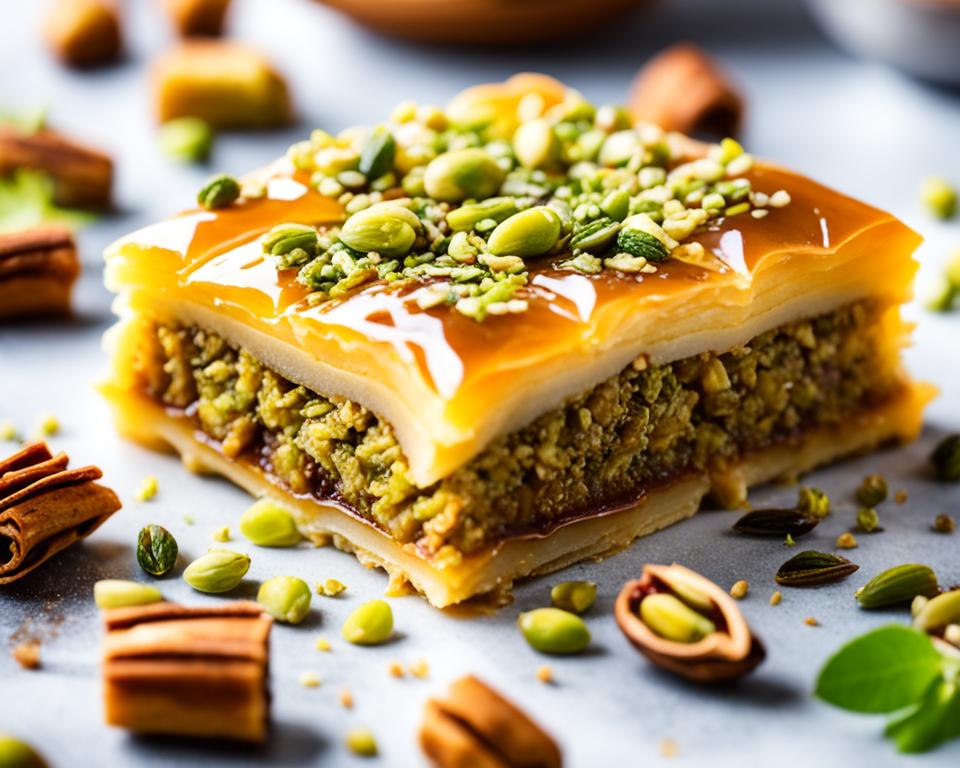
One could even introduce exotic spices or fruit layers for a fusion baklava that offers a tantalizing twist on the familiar. Whether embellishing with a sprinkle of cardamom, rose petals, or even layers of figs, these inventive embellishments promise a baklava that defies expectations while honoring its storied pedigree.
Vegetarian and Vegan Adjustments
For those favoring vegetarian baklava or vegan desserts, there are plenty of alternatives that allow for a similar texture and taste profile. Plant-based butter can seamlessly replace dairy, and vegan-friendly syrups can offer the same sticky sweetness essential for the perfect syrup-soaked finish. With these small adjustments, baklava becomes an inclusive delight without compromising its signature flakiness and rich taste.
Whether you’re looking for a way to impress at your next dinner party or simply experimenting with new Greek Desserts, personalizing your baklava recipe can be both fun and rewarding. So, go ahead, add your personal touch to this classic dessert and enjoy the rich, flaky, and nutty goodness of your very own customized treat.
Baklava Troubleshooting: Common Mistakes to Avoid
Embarking on the journey to perfect your homemade Greek desserts, specifically baklava, means being prepared to tackle some common errors that might arise along the way. Achieving the dream of crafting an easy baklava recipe is attainable, yet it’s critical to avoid certain pitfalls for that quintessential moist and flaky final product, which sets apart homemade baklava from the rest.
First and foremost, using phyllo dough that is too thick is a frequent mistake that could result in a dense and doughy baklava rather than the desirable airy layers. The trick lies in acquiring paper-thin sheets that allow you to create those delicate layers, fundamental to a flaky baklava texture.
Another key point of failure is not being generous enough with the butter. Each sheet of phyllo should be sufficiently coated to ensure that, once baked, the pastry layers stick together cohesively and boast a golden glow complemented with a tender crunch. Skimping on butter may lead to lamentable, dry layers that detract from the indulgence expected in Greek desserts.
Lastly, the syrup application can make or break your baklava. It’s essential that the proper technique is embraced to prevent sogginess. Homemade Baklava Tips often emphasize that the syrup must be evenly poured over the hot pastry right after baking to ensure proper absorption, contributing to an authentic baklava experience where every mouthful is imbued with the sweet, fragrant syrup.
- Ensure phyllo dough is thin for optimal layering.
- Use enough butter for each layer to maintain moisture and taste.
- Apply the syrup correctly to avoid sogginess while still achieving sweetness.
Steer clear of these typical troubles with your baklava and your dessert will not only be a conversation starter but an unforgettable serving of Greek hospitality. Remember, an Easy Baklava Recipe doesn’t mean cutting corners on quality or tradition.
Pairing Your Baklava with the Perfect Beverage
Indulging in the classic delight of Greek Desserts with a slice of homemade baklava is a ritual of sweetness, meant to be savored slowly. To further elevate this experience, an astute pairing with the right beverage is essential. Whether you follow tradition or wander into modern tastes, the correct drink will enhance the layers of flavor in your Traditional Baklava Recipe. Let’s delve into time-honored drinks as well as contemporary sips that can transform dessert into a full-spectrum gastronomic event.
Traditional Drinks to Accompany Baklava
When considering Dessert Pairings, especially for a dessert as storied as baklava, we often look to history for guidance. The rich, nutty layers of baklava are perfectly complemented by the strong punch of Greek coffee. This traditional duo dances in harmony, the robust coffee contrasting with the sweet, sticky mouthfeel of the dessert, creating a balance favored in Mediterranean circles. For those who prefer a smoother companion, the sweetness of Samos wine, with its fruity undertones, brings out the nuanced flavors of this Traditional Baklava Recipe for a truly classic enjoyment.
Creative Cocktails and Brews for a Modern Twist
In the modern culinary landscape, where fusion and innovation are celebrated, Baklava Pairings can take an adventurous turn. Imagine sipping on a cocktail infused with aromatic botanicals that echo the essences of the baklava’s honey and spice. Specialty brews, such as a porter with notes of caramel or a spiced ale, can also lend a contemporary edge to the pairing, providing a complex yet satisfying counterpoint to the richness of the dessert.
Consider Modern Dessert Drinks like a crafted cocktail with hints of orange blossom or rose water that mirror the scents of a traditional Syrian or Lebanese baklava. Not only does this create a modern flair, but it also pays homage to the dessert’s varied cultural background. It’s all about finding that beverage which both contrasts and complements, offering a unique and holistic tasting adventure that enhances each bite—a nod to the evolving world of Greek Desserts and their place in a global gastronomy.
From History to Plate: Why Baklava is a Timeless Treat
The inception of Traditional Baklava Recipe dates far back, intertwining through the tapestry of time, where each layer speaks to centuries of tradition and culinary evolution. This delectable delight stands as a pinnacle among Greek Desserts, a sweet testimony to the mastery of generations of artisans whose skillful hands crafted what we savor today.
Baklava’s layers are more than a mere confluence of butter, nuts, and phyllo. They represent a palimpsest of gastronomy, capturing the essence of what makes Timeless Desserts continue to appeal across continents and epochs. The cradle of such a masterpiece lies within the heart of historical innovation, from the Assyrian empire to the palatial tables of Ottoman sultans, and finally gracing our modern plates.
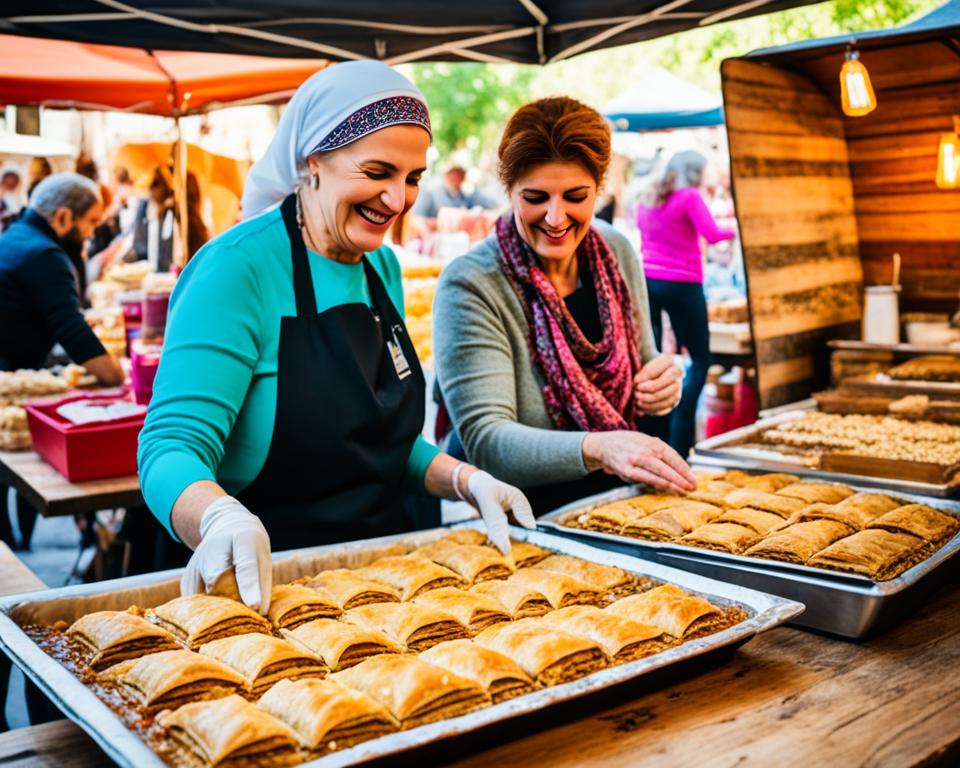
Regarded as a fine work of edible art, an authentic Traditional Baklava Recipe encompasses a diverse range of flavors and textures, its crispy, golden phyllo dough encasing the rich, sweet filling. This intimate amalgamation of ingredients has culminated over time into a dessert that symbolizes a cross-cultural bridge, a confection that is adored and celebrated in equal measure within an array of cuisines and by countless fans.
The reason baklava endures as a Timeless Dessert rests not only on its harmonious flavors but also on the stories it carries from one generation to the next. One could argue that in each bite, there exists a lesson in history, a bite-sized journey through the annals of human civilization and its intersection with the migration of culinary traditions.
Each crumb of baklava whispers tales of trade routes and culinary cross-pollination, an edible allegory of human connection and shared heritage.
Therefore, it is no mere hyperbole to suggest that when one indulges in a piece of baklava, they are, in fact, partaking in a ritual as ancient as the civilizations that gifted us this heavenly dessert. It is here, in the sweet, layered embrace of baklava, that we find a confectionery link to our past, a reason why it endures in the present, and a certainty that it will continue to be celebrated in the future as a Timeless Dessert.
- The enduring appeal of baklava transcends cultural and temporal boundaries.
- Every baklava recipe tells a story, contributing to its status as a timeless delicacy.
- The rich history of baklava is embedded in every layer, making it a dessert with a tale.
Conclusion
The journey through the layers of Perfect Flaky Baklava culminates in a dessert that is much more than the sum of its parts. It encapsulates the richness of Greek Desserts, delivering a multi-sensory delight designed to please the palate. We’ve witnessed the transformation of simple ingredients like nuts, phyllo dough, and syrup into a Homemade Baklava that is drenched in history and flavor.
Savoring the Sweetness: Recap of the Perfect Flaky Baklava Recipe
Every honey-soaked bite of this Best Baklava Recipe encompasses the crisp and tender textures synonymous with its accolades. The dedication it demands is evident in its flaky layers, each a testament to the love poured into its creation. From the sweetness of the honey to the tartness of the lemon, and the richness of the mixed nuts, this dessert stands as a pinnacle among Greek Desserts.
Final Thoughts: The Joy of Sharing Homemade Baklava
In the grand tapestry of desserts, Sharing Desserts, especially those with the complexity and heritage of baklava, is an act of communion. Serving up Homemade Baklava is more than sharing a dish; it’s about imparting a piece of history, an experience steeped in tradition, and a piece that speaks of welcome and festivity. As you pass each piece to friends and family, you’re extending an age-old gesture of generosity, one that is as heartfelt as it is sweet.
FAQ
What are the key ingredients for homemade baklava?
The essential ingredients for homemade baklava include delicate phyllo dough, a blend of finely chopped nuts such as walnuts, pistachios, hazelnuts, or pecans, and a honeysweet syrup made from honey, lemon juice, sugar, and water, along with cinnamon for spicing the nut mixture.
Can baklava be made with different types of nuts?
Absolutely. While traditional baklava recipes commonly utilize walnuts or pistachios, you can use a combination of nuts like hazelnuts or pecans to create a unique nutty baklava flavor profile.
How thin should the phyllo dough be for baklava?
The phyllo dough for baklava should be exceptionally thin, even thinner than paper, and it’s crucial to keep it moistened with butter during the layering process to ensure it bakes up flaky and tender.
What’s the significance of the honey-lemon syrup in baklava?
The honey-lemon syrup is the main sweetening agent of baklava, soaking into the layers to provide moisture and a balanced sweetness that’s not overpowering. The addition of lemon juice adds a subtle citrus hint that complements the cinnamon and nut flavors.
How do you properly layer baklava?
Properly layering baklava involves alternating sheets of buttered phyllo dough with the spiced nut mixture. This process must be done meticulously to achieve the traditional flakiness once baked.
At what temperature should baklava be baked?
Baklava should be baked in an oven preheated to 325ºF. This temperature allows the pastry to cook through evenly without burning, achieving a perfect golden-brown finish.
How do you store baklava to keep it fresh?
To maintain freshness, store baklava at room temperature, covered with a tea towel for up to two weeks. Alternatively, if a chewier texture is preferred, baklava can be stored in the refrigerator.
Can baklava be made vegan or vegetarian?
Yes, baklava can be adapted for vegetarian or vegan diets by using plant-based butter and appropriate syrups, ensuring the dessert retains its signature flakiness and rich taste.
What common mistakes should I avoid when making baklava?
Avoid using phyllo dough that is too thick, skimping on the butter, or improperly applying the syrup. These mistakes can lead to dry layers or a dessert that doesn’t hold together well.
What is the ideal drink to pair with baklava?
Baklava pairs delightfully with strong coffee or sweet Samos wine. For a modern twist, you can also try it with a creative cocktail or craft brew that complements its rich, sweet, and nutty flavor profile.
What cultural significance does baklava have?
Baklava holds a treasured spot in many cultures, often linked to Greek and Middle Eastern traditions. It is a dessert that is associated with hospitality and celebration and is enjoyed during significant festivals and gatherings.
Can you suggest any variations for a traditional baklava recipe?
To customize your baklava, consider adding chocolate, different nuts, or even experimenting with spices to elevate the dessert. The recipe is versatile, allowing for a wide range of creativity while preserving traditional flavors.
How long should baklava cool before serving?
Once baklava has finished baking and the syrup has been applied, it should cool completely at room temperature. For the flavors to fully develop, it’s best to let it sit for 4-6 hours, or ideally overnight, before serving.
Why does my baklava get soggy?
Baklava can become soggy if the syrup is too hot when poured over the pastry or if it’s not allowed to absorb properly. Ensure that the syrup is cool and the baklava is hot when combining them, and allow sufficient time for the dessert to rest and develop its texture before serving.
Is baklava a dessert for special occasions only?
While baklava is often served during special events and holidays, it’s also a delightful addition to any meal as a dessert. Its timeless appeal and indulgent flavors make it a treat to be savored whenever the mood strikes.

